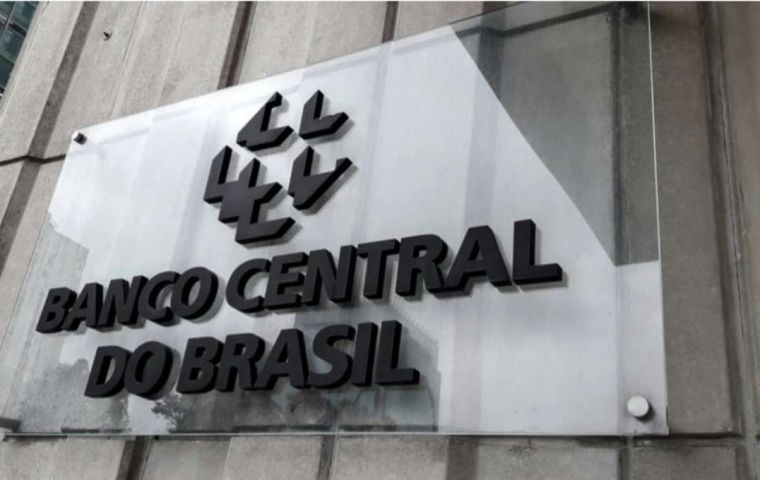MercoPress. South Atlantic News Agency
Brazil: Selic rate upped for the seventh straight time
 The Copom's decision was unanimous
The Copom's decision was unanimous Despite falling inflation, Brazil's Central Bank (BCB) raised the Selic interest rate on Wednesday by 0.25 percentage points to 15%, its zenith since 2006, citing ongoing economic uncertainty. The unanimous Monetary Policy Committee's (Copom) move surprised local markets, who anticipated it would stay at 14.75%.
“If the expected scenario is confirmed, the Committee anticipates an interruption in the interest rate hike cycle in order to examine the accumulated impacts of the adjustment already made, which have yet to be observed, and then assess whether the current level of the interest rate, considering its maintenance for a fairly prolonged period, is sufficient to ensure the convergence of inflation to the target,” the Copom said in a statement.
“The committee emphasizes that it will remain vigilant, that future monetary policy steps may be adjusted, and that it will not hesitate to continue the adjustment cycle if it deems it appropriate,” it added after the seventh increase in basic interest rates in a row.
From September last year to May this year, the Selic was raised six times. After reaching 10.5% a year from June to August last year, the rate began its upward trend in September last year, with a 0.25-point increase, followed by a 0.5-point increase, three 1 ppt increases, and one 0.5-point adjustment.
The Selic rate is the Central Bank's main instrument for keeping official inflation, as measured by the Broad National Consumer Price Index (IPCA), under control. In May, the Broad National Consumer Price Index, which measures official inflation, fell to 0.26%, despite pressure from some foodstuffs and energy bills. With this result, the indicator has accumulated an increase of 5.32% in 12 months, above the ceiling of the continuous inflation target.
Under the new continuous target system in force since January, the inflation target to be pursued by the Central Bank, set by the National Monetary Council, is 3%, with a tolerance interval of 1.5 percentage points up or down. In other words, the lower limit is 1.5% and the upper limit is 4.5%.
In the continuous target model, the target is calculated month by month, taking into account inflation accumulated over 12 months. In June 2025, inflation since July 2024 is compared with the target and the tolerance interval. In July, the procedure is repeated, with calculation from August 2024. In this way, the verification shifts over time and is no longer restricted to the closed index in December of each year.
In the latest Inflation Report, released at the end of March by the Central Bank, the monetary authority raised the IPCA forecast for 2025 to 5.1%, but the estimate could be revised depending on the behavior of the dollar and inflation. The next report will be released at the end of June.
Market forecasts are more pessimistic. According to the Focus Bulletin, a weekly survey of financial institutions published by the Central Bank, official inflation is expected to close the year at 5.25%, almost 1 point above the target ceiling. A month ago, market estimates stood at 5.5%.
The Copom communiqué contained the Central Bank's updated inflation expectations. The monetary authority predicts that the IPCA accumulated over 12 months will reach 4.9% in 2025 (above the target ceiling) and 3.6% at the end of 2026. This is because the Central Bank is working with what it calls an “extended horizon”, considering the inflation scenario for up to 18 months.
The Central Bank slightly increased its inflation estimates for this year and maintained those for next year. At its previous meeting in November, the Copom forecast IPCA of 4.8% in 2025 and 3.6% over 12 months at the end of the second quarter of 2026.
The increase in the Selic rate helps to contain inflation because higher interest rates make credit more expensive and discourage production and consumption. On the other hand, higher rates hinder economic growth. In its latest Inflation Report, the Central Bank reduced its growth projection for the economy in 2025 to 1.9%.
The market is projecting better growth. According to the latest edition of the Focus Bulletin, economic analysts forecast GDP expansion of 2.2% in 2025.
The basic interest rate is used in government bond trading on the Special Settlement and Custody System (Selic) and serves as a benchmark for other interest rates in the economy. By adjusting it upwards, the Central Bank curbs the excess demand that puts pressure on prices, because higher interest rates make credit more expensive and encourage savings.
By reducing the basic interest rate, the Copom cheapens credit and encourages production and consumption, but weakens inflation control. To cut the Selic rate, the monetary authority needs to be sure that prices are under control and are not in danger of rising. (Source: Agencia Brasil)




Top Comments
Disclaimer & comment rulesCommenting for this story is now closed.
If you have a Facebook account, become a fan and comment on our Facebook Page!